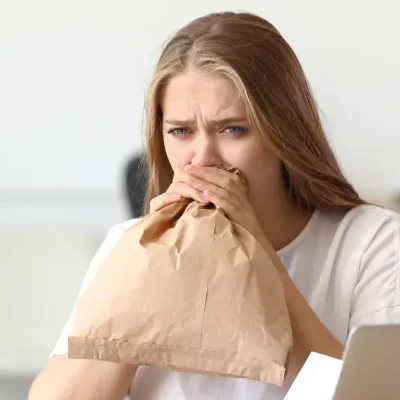Experiencing anxiety or panic disorders is more common than you might think. Around 40 million people each year in the U.S. face anxiety disorders every year, making it the most prevalent mental health condition.
It can be difficult to know the difference between a panic attack vs anxiety attack. There are many similarities, but knowing which you may suffer from can help determine which coping skills and treatments to use to find relief faster.
In this article, we will explore the symptoms of panic and anxiety attacks, highlight key differences between the two, review available treatments, and provide guidance on seeking help to reduce the impact of these disorders.
Example exercise: Is it anxiety or panic?
Here are some examples of panic attacks and anxiety attacks to help you distinguish between the two.
Example 1:
Alice was waiting in line at the grocery store when she began to feel a tightness in her chest and shallow breathing. She started to worry about what other people were thinking of her and became increasingly anxious. She felt like she couldn’t move, or breathe properly and her heart rate increased. In a few moments, the attack passed but left Alice feeling scared and exhausted.
Example 2:
John was getting ready for an important presentation at work when he started to feel overwhelmed and shaky. His thoughts racing, his palms began to sweat and he felt like his heart was pounding out of his chest. He started to question all the preparation he had done for the presentation, worrying that it would not be good enough. The passed after several minutes but John was left feeling drained and worried about how he would perform during the presentation.
Example 3:
Jane was driving home from work when she suddenly experienced a sharp pain in her chest followed by dizziness and difficulty breathing. Her heart raced uncontrollably as fear set in, causing her hands to shake uncontrollably on the wheel as she pulled over to the side of the road. Unable to concentrate or think clearly, Jane felt like she was going to faint or die right there on the spot. After several minutes of deep breathing exercises, Jane slowly regained control and drove home safely – shaken but relieved that it had eventually subsided.
Alice and John both experienced anxiety attacks, while Jane experienced a panic attack.
This post will explain the differences between the symptoms of anxiety and panic attacks, the 4 key differences so you can tell the difference between the two, and understand the available treatments for both disorders.
Symptoms of an anxiety attack
Anxiety is a common emotion that can range from slight unease to extreme fear and distress. You can feel anxiety from time to time without being diagnosed with an anxiety disorder.
Anxiety is characterized by feelings of:
- Feeling overwhelmed and tense
- Difficulty breathing/rapid breathing
- Increased heart rate
- Racing thoughts
- Nausea or upset stomach
- Dizziness or trembling
- Sweating, shaking, or chills
Everyone experiences anxiety at some point in their lives, and when it begins to interfere with normal functioning or causes distress then it may be time to seek professional help.
An anxiety attack involves a combination of the above symptoms in an exaggerated degree, often overlapping with symptoms of a panic attack, leading to intense feelings of fear and dread. During an anxiety attack, you may feel as though you are losing control or experiencing a heart attack due to overwhelming physical and emotional sensations.
Other common characteristics of anxiety include:
- rapid breathing (hyperventilation)
- involuntary crying or screaming out loud
- feeling faint
- uncontrollable shaking
- numbness or tingling in fingers or face (due to hyperventilation)
These attacks can last anywhere from a few minutes to an hour at a time depending on individual factors such as coping mechanisms.
Symptoms of a panic attack
Panic attacks are periods of intense fear that come on suddenly with little to no warning signs at all.
The symptoms of a panic attack can include:
- Rapid heartbeat or palpitations
- Sweating and/or chills
- Shortness of breath or difficulty breathing
- Nausea, dizziness, and feeling lightheaded
- Chest pain or tightness in the chest area
- Feelings of terror, fear, helplessness, or impending doom
- Hot flashes and/or cold chills
Panic attacks generally last between five minutes and half an hour, although in some cases they may extend to an hour.
Panic attacks can also be accompanied by other physical and psychological symptoms such as difficulty concentrating, fear of losing control or going crazy, feeling scared or anxious in general, and even a sense of unreality (depersonalization) where you feel emotionally or physically numb to the world around you, or where thoughts and feelings seem “unreal”.
Panic attack vs anxiety attack: The 4 main differences
Although some physical symptoms due to both attacks overlap, there are some major differences that help differentiate between the two.
1. Onset of attack:
Panic attacks tend to appear suddenly and without warning, while anxiety attacks develop gradually, with fear or tension building over time.
Also, anxiety attacks have a clearer build-up, peak, and ending, usually accompanied by a feeling of exhaustion when finished. Panic attacks tend to go from 0 to 100 quickly, and persist at an intense rate for a longer period of time. The end of a panic attack seems less clear than an anxiety attack.
2. Severity of attack:
Panic attacks are intense and feel life-threatening, while anxiety attacks are typically more subtle and less intense than attacks, although both are capable of causing distress and interfering with daily activities.
3. Differing symptoms during an attack:
Both anxiety and panic attacks can include symptoms of anxiety, panic attacks include more physical distress, such as terror, feelings of impending doom, chest pain, rapid heartbeat, and de-personalization.
4. Length of attack:
Anxiety attacks may last for 2 minutes to an hour at a time, whereas panic attacks typically last anywhere from five minutes to half an hour – although some have reported longer episodes.
By understanding the differences between panic and anxiety attacks, you can begin to develop strategies for managing them both more effectively and learn how to prevent future episodes from occurring.
What causes panic and anxiety disorders?
Panic and anxiety disorders can be caused by a number of different factors, including genetic predisposition, psychological trauma or stress, and underlying medical conditions or mental disorders. It is believed that a combination of biological and environmental factors can lead to the development of these disorders.
Genetic predisposition:
Research has shown that family history plays a role in the development of panic and anxiety disorders. If you have a close relative with anxiety or panic disorder, you are more likely to develop one as well. This does not mean that if one family member has a panic or anxiety disorder though, others in the family will automatically be prone to them; it simply suggests that there may be certain genetic components at work.
Psychological trauma or stress:
Life events such as the death of a loved one, abuse, or other traumatic experiences can trigger the onset of symptoms associated with panic and anxiety disorders. Stressful life events may also increase vulnerability to developing these conditions, as they often lead to changes in self-esteem, moods, ability to cope with difficulties, and general outlook on life. Furthermore, prolonged exposure to high levels of stress hormones like cortisol can damage brain structures that are important for regulating emotions and behavior.
Underlying medical conditions:
In some cases, you may experience anxiety due to underlying medical conditions such as thyroid disease or autoimmune diseases like lupus. In addition, drug use (especially stimulants such as cocaine), alcohol abuse, lack of sleep, caffeine over-consumption, and chronic pain have all been linked to heightened levels of anxiety.
Overall, while there is no single cause for developing an anxiety or panic disorder, it is important to recognize the potential triggers so that proper treatment measures can be taken. If you are experiencing symptoms related to either condition it is important to seek help from your doctor or mental health professional right away in order to begin managing your condition effectively.
Treatment of anxiety and panic disorders
Anxiety and panic disorders are highly treatable. There are a variety of treatments available, and most people respond best to a combination of these options.
Cognitive behavioral therapy (CBT):
The first line of defense for treating both panic attacks and anxiety attacks is cognitive behavioral therapy (CBT). CBT is a form of psychotherapy that helps change your thoughts and behaviors in order to reduce the symptoms of anxiety or less frequent panic attacks.
During CBT, your therapist will work with you to identify unhealthy thought patterns that are contributing to the development or maintenance of your disorder, as well as work on techniques to replace these thought patterns with healthier ones.
This type of therapy also focuses on helping you learn how to appropriately react when you feel like you’re having anxiety or panic attacks, such as deep breathing exercises, relaxation techniques, and even mindfulness practices.
Dialectical behavioral therapy (DBT):
Dialectical behavioral therapy (DBT) is a type of cognitive-behavioral therapy that has been found to be effective in treating anxiety and panic disorders. It combines traditional cognitive behavioral techniques with mindfulness practices, allowing you to become more aware of your thoughts and behaviors while learning how to manage them effectively.
DBT focuses on helping you recognize and identify any unhelpful thought patterns or behaviors you may have adopted that are contributing to your disorder, as well as teaching you new ways of thinking and responding in order to reduce symptoms.
This approach also helps you learn how to better regulate emotions, build interpersonal skills, improve problem-solving abilities, and develop distress tolerance so that you can cope better when faced with difficult situations.
Ultimately this form of psychotherapy can provide you with the tools necessary for managing both anxiety and panic attacks more effectively over time.
Exposure therapy:
Exposure therapy is a form of psychotherapy that can be used to treat various anxiety disorders and panic disorders. It works by gradually exposing you to the source of your fear or distress in a safe and controlled environment, allowing you to learn how to cope with difficult situations without feeling overwhelmed.
Exposure therapy has been found to be particularly effective for those suffering from phobias, post-traumatic stress disorder (PTSD), obsessive-compulsive disorder (OCD), as well as generalized anxiety disorder (GAD).
The goal of exposure therapy is not necessarily for you to become completely fearless; its goal is for you to be able to manage your response when faced with challenging situations. During treatment sessions, your therapist will work with you on techniques such as deep breathing exercises and mindfulness practices which can help reduce symptoms associated with anxiety or panic attacks.
Over time this approach allows you to slowly confront your fears until eventually you are no longer affected by them in an overpowering way. By doing so it helps you regain control over your life while also learning useful skills for managing stress and anxiety in the future.
Medication:
Medication is another option for treating anxiety attacks and panic attacks. The most commonly used medications are antidepressants or anti-anxiety medication, which help by reducing feelings of worry, fear, or restlessness while also helping to improve sleep quality.
While some medications may cause side effects such as drowsiness or headaches, these should start to diminish once the body adjusts to them over time. If considering medication, consult with your doctor to discuss potential side effects and ensure the treatment aligns with your specific needs.
Lifestyle changes:
Lifestyle changes can be helpful in managing your anxiety or panic disorder. For example, physical activities have been found to help reduce stress hormones and increase endorphins (the “feel-good” hormones) in the body which can lead to improved mental health and mood overall.
Also, avoiding stimulants such as caffeine can also be beneficial in reducing symptoms associated with anxiety and panic attacks.
Additionally, focusing on getting adequate amounts of sleep each night is key – research shows that lack of sleep can heighten your risk factors for these types of issues. Making sure you get enough rest every night can help keep your body balanced and functioning at its best so that it can better cope with stressful situations.
Overall, while managing anxiety and panic disorders can be a challenging endeavor, with the right combination of online therapy, medication, and lifestyle changes it is possible to find relief and live a healthy life.
What will work for me?
It’s important to note that what works for one person may not work well for another. Everyone reacts differently to treatments and coping skills. It is normal to try popular calming methods and notice it doesn’t give you the desired result. That’s ok! There are many to choose from and you will find ones that work for you.
Also, what worked for you during a past attack may not have the same effect in the future. This can often feel discouraging because what worked to calm you during one may not work during another. This is also normal! A coping skill that works 50% of the time, it’s still valuable in managing panic attacks or anxiety attacks. Building a toolkit of coping methods ensures you’re prepared for any episode.
The answer to this issue is creating an arsenal of coping skills and knowing when to stop using one skill and start another one in an effort to calm the panic or anxiety attack down. Having an arsenal or list of different coping techniques that you have practiced can help you feel prepared and confident that you have multiple tools at your disposal to help you through an attack successfully. Incorporating a range of coping strategies can help reduce both the intensity and duration of panic or anxiety attacks.
Now that you understand the differences between a panic attack vs anxiety attack, know that both are highly treatable conditions. If you’re struggling to manage your anxiety or panic disorder on your own, it may be beneficial to connect with a therapist to help guide you in coping with anxiety.
A trained counselor can help you identify the underlying causes of your panic and anxiety attacks and develop strategies for managing symptoms in both the short-term and long-term. With their support, you can gain insight into your condition, learn ways to cope with difficult emotions, and ultimately regain control over how these issues affect your life.
Don’t hesitate to reach out if you’re feeling overwhelmed – there are professionals available who understand what you’re going through and have the expertise needed to provide effective treatment options that will work best for you! Call us or schedule an appointment to make an appointment and begin your healing journey today!
More about this:
For additional resources, check out some of our other blog posts on coping with anxiety and panic:
Panic Attacks And 3 Powerful Tips To Calm Down









This Post Has One Comment
The insights provided here shed light on the distinctions between panic attacks and anxiety attacks, offering a valuable perspective.